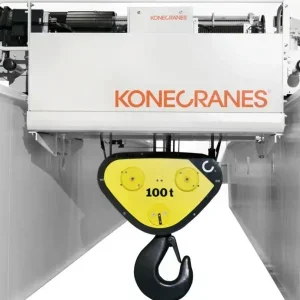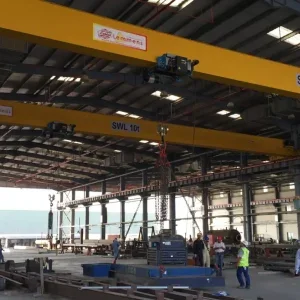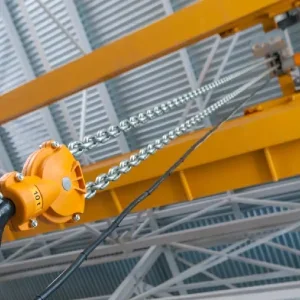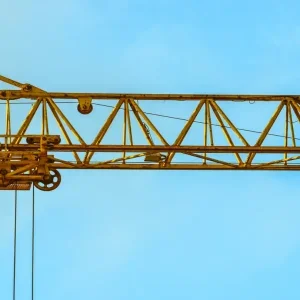Morris Inc lawsuit against Konecranes to go ahead
A motion to dismiss a lawsuit brought by Morris Material Handling Inc/P&H against KCI Konecranes has been denied.
Following the denial of the motion to dismiss, a date of 6 March 2006 has been set for the trial. Lists of expert witnesses and other research are due in January.
When it filed suit against Konecranes Inc and its Finnish parent company KCI Konecranes in October 2003, Morris alleged that the companies made their own parts for P&H cranes and passed them off as genuine to gain access to the lucrative P&H spare part business. As part of its formation in 1998, Morris licensed the P&H name from the original owners Harnischfeger. For the suit, a company executive ordered some spare parts under an assumed company.
In its complaint, Morris estimated there were 30,000 P&H cranes still in use, and 50,000 P&H hoists in the US. It reported that its revenue for supplying P&H parts was $42.4m in fiscal 2002 – not including service.
Morris also alleges that KCI Konecranes attracted P&H parts buyers by including the words ‘P&H’ and ‘Morris’ in so-called ‘metatags’ within in some subsidiaries’ web sites, including Lloyds Konecranes of the UK, which it argues “much of its content is based toward United States based crane standards.” These metatags are invisible to many users, but can be picked up and used to rank results of searches in Internet search engines.
The Morris suit was followed several weeks later by a countersuit by KCI Konecranes and Konecranes Inc, and, in late November, a motion to dismiss the case. In their counterclaim, they denied most of the allegations, and claimed that Morris had improperly kept a deposit of $250,000. KCI Konecranes said it paid the sum in November 2002 with the intention of buying the rest of the company. But following further research, the company changed its mind, but said it did not get the money back.
They also objected to Morris’s tactics in ordering spare parts, arguing it “subverted the market”. They complained that Morris has been “systematically recruiting, soliciting and hiring” Konecranes Inc employees following the failure of negotiations to buy Morris, a period in which they said Konecranes Inc was committed not to recruit Morris employees. They also allege that Morris induced a Konecranes Inc employee Morris had recruited to pass on Konecranes Inc trade secrets. They contend that Harnischfeger is the only body with the right to contest the trademark infringement, and that the P&H mark has been abandoned in the aftermarket parts business, among other arguments.
In a reply, Morris admits that its holding company – Morris Material Handling Holdings Inc – has held on to the $250,000 sum, but it says it has done so ‘consistent with the terms of the agreement.’ It further argues that Morris Material Handling Inc itself did not sign up to the agreement. Although it admits that Morris hired an employee referenced in the suit, it denies that it induced him to steal trade secrets.
In its motion to dismiss on grounds that the claim is outside of personal jurisdiction, KCI Konecranes argued that it does not itself do business in the USA, and would be unfair for a foreign company to be tried in the States. In an affidavit supporting the motion, Konecranes Inc senior vice president Guy Schumaker said that the US company is separated by two subsidiaries from its Finnish parents. Konecranes Inc is a wholly-owned subsidiary of KCI Holding USA (of which Schumaker is treasurer), which is a wholly owned subsidiary of Konecranes Finance OY (of Finland), which is a wholly-owned subsidiary of KCI Konecranes.
Following several more briefs and responses to the motion to dismiss, chief judge Rudolph T. Randa of the Eastern District of Wisconsin US District Court denied the motion in September.
In his decision to deny the motion, Randa wrote that the issue of personal jurisdiction is based partly on the amount of contact KCI Konecranes has with customers in the US. “KCI cannot disavow its connection to the web sites because it copyrights the web sites and owns all of the contents contained therein,” Randa said, adding that KCI Konecranes did not deny that the metatags exist on its web sites, and have existed for four years. “In addition, the major market for the cranes and parts identified by Morris’s trademarks is in the United States,” he said. “To the extent that the trademarks are, in fact, used as metatags, they are clearly directed at the market for those cranes and parts. Thus, KCI purposefully availed itself of U.S. customers by way of its ownership of web sites directed at those customers. This Court finds that KCI has the necessary minimum contacts to establish personal jurisdiction without offending the traditional notions of fair play and substantial justice.”
Pic: lloyds web page
CM launches drives for chain hoists
Columbus McKinnon has launched a variable frequency drive for its standard hoist products, ‘primarily’ its three-phase 460V or 230V CM Lodestars, Coffing EC hoists and the Budgit Manguard, according to Art Zobal, packaged hoists product manager. The drive is small enough to mount onto the existing hoist housing.
The drive can be reprogrammed in the field from infinite variation using two-step push button controls to any intermediate predetermined range. The device also helps prevent current spikes on startup and allows a creep speed without having to press the button in sequence, which can wear out the motor. Other features include motor thermal overload protection, and fault history.
The drive works with a standard AC squirrel cage induction motor without magnetic contactors.
Pic: VFD2.tif
Demag supplies Airbus fuselage cranes
Demag Cranes and Components has supplied three cranes to an Airbus factory in Nordenham, Germany for manufacturing the wide-body A380 aircraft.
Two of the cranes (32m and 37m span) transport sections of ‘skin’ – the outer surface of the aircraft – to workstations for assembly and riveting. The third (39m span) lifts the fuselage section into a secondary treatment facility. Each section can measure 10.8m long, 6.7m wide, 2.3m high and weigh 1.6t.
During the assembly process, fuselage sections must be turned from vertical to horizontal, and back again. To move the sections in this way, the double-girder EOTS have been fitted with a rotating crab in an H-shaped frame spanning 7m. Two travelling hoists run along each of the two 11m load beams that form the sides of the H. Hoist and travel motors were fitted with inverters.
Pic: hc. News 1
Abus launches 4t chain hoist
German hoist manufacturer Abus has launched a 4t capacity chain hoist. The hoist, now available for sale throughout Europe, has a capacity twice that of the company’s largest 2t model.
“Something from time to time we’ve noticed, when building a 3.2t crane rather than a 3t, is that a 4t wire rope hoist compared to someone else’s chain hoist is a little too expensive. As we were developing a new hoist anyway, we extended it through 4t,” says Abus UK general manager David Edwards.
“We had no chance of winning an order for a 4t crane pitting a high quality wire rope hoist against a cheap chain hoist. Now, at least it means fighting a level playing field.”
Then what we do is offer the price that we feel is fair, and occasionally have to say, “all right, we’ll talk to you about money,” Edwards says.
Like its smaller siblings, the GM8 has two speeds, with a ratio of 1:6. Maximum speed is 20m/min.
Edwards said the company does not get much competition for chain hoists above 4t capacity, because of their sheer size. The hoist uses a square-profile hardened chain, which the company says is 25% harder than a round chain.
The hoist has been available for a year in the German domestic market.
Morris opens crane factory in Monterrey, Mexico
Morris Material Handling Inc has opened a crane assembly facility in Monterrey, Mexico. The Monterrey factory opened in September and as of early October had already shipped its first units – two 30m span cranes of 30t and 15t capacity for the Queretaro, Mexico facility of metals firm Serviaceros Planos. The plant opening follows the closure of a similar plant in Mexico City.
The Monterrey factory complements Morris Materials Handling Inc’s four other North American crane assembly factories in North America. There are two in Canada – Morris’s dealer Overhead Crane Service in Burlington, Ontario and Kaverit Crane in Edmonton, Alberta – and a plant in Birmingham, Alabama and another specialising in process cranes in Franklin, Ohio. The company also operates a machine shop producing gearing and wheel assembly and builds hoists for all of North America in Milwaukee, Wisconsin. Its refurbishment operations take place at a plant in Windsor, Wisconsin.
Picture 06183123.jpg: Morris’s Monterrey facility General Manager Andres Islas, left, and Morris Material Handling vp and general manager of P&H Cranes, Hoists and Equipment, Jeff Breitric
JDN’s new winches
JD Neuhaus has launched six pneumatic winches up to 3t in capacity. The two new Profi Lifter models’ capacities are 1t and 1.8t; the two new Profi Pullers are rated at 1.6t and 3t, and the two Profi Eco models are rated at 500kg and 800kg. Lifter and Puller have explosion classification of II 2 GD IIA T4(X)/II 3 GD IIB T4(X) with increased spark protection.
All have a self-lubricating vane motor with integrated brake. Nominal air pressure required is 4 bar (65 psi) or 6 bar (85 psi). A planetary gear that is cooled by exhaust air is integrated into the drum. Overload protection is standard. The drum’s expected d/d ratio is 21 and holds up two four wraps of rope.
Pic: hc. News 2
Steel-core roundsling
Dutch stage rigging firm Prolyte has launched a soft sling with wire rope core for the stage rigging market. Intended for high-temperature work where soft slings might burn or melt – such as rigging stage lights – the ‘Softsteel’ has a core of unbraided wire rope strands, each 2mm in diameter.
The endless sling has a limit of 2t and lengths of 0.5m, 1m and 2m.
Outside webbing is black, with grey identification label and a concealed examination window to inspect the steel wires.
The company claims the sling is as flexible as a soft sling.
It is manufactured in the Netherlands by wire rope manufacturer Roodenberg Staalkabel and distributed by Prolyte. The company said it has been on trial for two years before serial manufacture began.
Pic: soft_steel.jpg
Stage hoist makes its debut
Aluminium truss manufacturer Prolyte has launched a stage hoist. ‘We are looking to broaden our product range and last year launched some staging products. We thought bringing out a hoist would complete our range,’ said a spokesperson.
The single-fall electric chain hoist is available in capacities of 500kg and 1t as of early October, though a 250kg and 2t hoists (with two falls of chain) are being rolled out this month. The company has also launched a range of five single-phase hoists lifting up to 500kg for exhibitions or perhaps retail shops. More models are to be rolled out in the coming months.
The Prolyft hoists are manufactured in the US by Coffing, to a Prolyte design – which includes soft handles and a special chain guide. Prolyte offers pendant controls to work them individually – radio remote control is not offered – or they can be actuated in groups with master controls manufactured by Prolyft in the Netherlands. All hoists have a factory-installed overload limiter that prevents more than 140% of rated capacity being hoisted.
The company has 13 service points in Europe, plus agents in Lebanon, Syria, Jordan, the Philippines, Singapore and Korea. If the hoist is serviced annually at one of these centres, Prolyte offers a lifetime warranty.
The company reports it has taken 10 orders in the first month.
pic: Prolyft 02.jpg
picture box story:
Swiss crane builder Gersag has won three major orders. The SWF customer has installed three wire rope cranes for maintenance at the new Swiss International Airlines hangar in Lucern. The underslung main girders are 43m long, lifting maximum 5t loads to 15m high.
Pic: swf10gersag_01.jpg
It also supplied a 30t capacity double-girder EOT for logistics firm Godrand for lifting standard containers. Crane span is 8.7m and runs along a 58m track. The crane used only one rope system, so the container can revolve up to 90°. The crane also automatically compensates for containers that are unevenly loaded.
Pic: swf10gersag_03.jpg
CMAA update
Jeff Breitrick, gm and vp international, Morris Material Handling Inc was elected president of the Crane Manufacturers’ Association of America at the annual conference of parent group the Material Handling Industry of America in September. Previously vice president, he replaces Steve Kosir, president Konecranes Americas as the leader of the US’s largest overhead crane trade association.
The new vice president is Oddvar Norheim, president of American Crane and Equipment Corporation, which distributes hoists built by Norwegian manufacturer Munck and manufactures cranes in the USA.
In the September sessions, work continued within the Hoist Manufacturers’ Institute (HMI) and the Monorail Manufacturers’ Association (MMA) on a “strategic review of the mission and vision” of the two organisations, according to managing director of both, Hal Vandiver. The effort is “intended to position both organizations to better serve the overhead material handling industry through their programming and leadership,” he said.
Vandiver also announced that work had begun on writing technical comparisons of international standards for overhead cranes and hoists. “Both CMAA and HMI are undertaking efforts to prepare for the public audience comparisons of the major worldwide performance and safety standards as they apply to overhead hoists and cranes. This will be done with the intent to educate users, specifiers and influencers so that they can make well informed decisions and selections regarding the purchase and subsequent application of this equipment and related systems.”
Brief items:
KCI Konecranes has set up a wholly-owned Italian subsidiary. Konecranes SRL, headed up by Jari Myyrylainen, is based near Milan. “For several years KCI Konecranes has been represented in the Italian market by distributors, JV-partners and licensees selling and marketing KCI Konecranes hoists and industrial cranes. However, KCI Konecranes’ product range covers much more than industrial cranes,” the company said.The company is also setting out to build a maintenance services network. ‘Service is provided for cranes of all makes regardless of original manufacturer,’ the company said.
The hierarchy of UK’s Morris Material Handling Ltd has changed following the retirement of chairman and CEO Mike Maddock in September. In his absence, Andy Miller – a 30-year company veteran – has been appointed commercial director. Steve Davis has been made managing director, responsible for finance, parts and service business and Morris operations in Saudi Arabia, Singapore and Thailand. Bill Oliver will become responsible for hoist and crane operations, and continue to manage sales, engineering, procurement and quality control.
UK lifting equipment inspection agency Buchan Inspection has appointed Derek Penny as general manager. Penny was previously GM of ABB Control Valves, and spent eight years as aftermarket director of Tyco Flow Control. Buchan Inspection is part of the UK’s Imes Group of engineering testing.
Following its acquisition of Somers Handling earlier in the year, UK lifting equipment firm Lloyds British Testing has acquired UK engineering firm Rumney Crane. Rumney Crane has a sales revenue of £2m ($3.5m) from its work selling lifting equipment to steelworks, ports and harbours in the UK and abroad. “The deal will allow us to reinforce our expertise in crane servicing and will develop our marketplace overseas in crane-related industries,” said chief executive Ian White, adding that the company intends to consider other acquisitions over the next year. The company now employs more than 300 people and has sales revenue of £18m.
pic: SV400009.JPG
Lift-It Manufacturing has launched a range of slings with toughened edges that it claims are more durable than normal slings. The Monster Edge sling ranges in capacity from 400kg to 10t hanging vertically at a 5:1 safety factor. The sling edges have a special yarn that is woven oversize and then reduced through a special process. Width ranges from 25mm to 100mm.
Pic: Monster Edge Picture.jpg
Morris Material Handling Inc has launched a water-soluble gear lubricant. The ‘Clean Crane’ lube helps reduce the impact of oil stains on steel carried by electric overhead travelling cranes. Because paint does not adhere to oil, leaking crane gears can ruin the finish on painted steel products. Morris’s synthetic gear lubricant is claimed to clean up with water, and can operate down to a temperature of –20°F (-28°C), and up to 140°F (60°C). The company notes it will break down oil-based gear case sealants such as Permatex, and so suggests existing users switch to a silicone-based sealant such as Loctite Superflex Red High Temp RTV. The company says the lubricant – $1,500 a 55 gallon barrel – costs no more than a high-end synthetic lubricant and smaller quantities can be sent anywhere in the world.
Managing Maintenance Planning and Scheduling by Michael V Brown has been released by Audel Books, a division of Wiley Publishing. The 266-page paperback book, about $30, was written by the president of New Standard Institute and includes chapters on estimating methods, preventitive and predictive maintenance, planning for shutdowns, performance indicators and more.
FKI Logistex has launched an electric high-bay warehouse storage and retrieval crane. The 1.5t capacity floor-running crane can reach up to 15m high. Maximum horizontal speed is 2.9m/s and vertical speed is .5 m/s.
Pic: clecocondor01.jpg
Letter to the editor:
NDT has been an accepted method of inspection of cranes ropes for a number of years especially in the oil industry. Companies such as Reel Inspection, Aberdeen will NDT and pressure lube a brand new crane rope before it is despatched to the client.
I believe quite a number of crane and lifting equipment companies especially those within the oil and gas area will find Mr. Reece’s claims very amusing.
Sean Sullivan, Caledonia Lifting and Certification Services
Letter to the editor:
Lloyds Konecranes’ NDT equipment is not the only service on the market. We have been inspecting crane ropes for over 10 years.
Reel is the only company with a DNV approved procedure and accredited to ISO9001:2000 by ABS for this service.
The [UK’s] Health and Safety Executive has published research comparing different types of NDT equipment, including our device, manufactured by NDT Technologies of the USA.
Rope degradation and damage, UK Health and Safety Executive, Offshore Technology Report 1999-033, October 1999. www.hse.gov.uk/research/otopdf/1999/OTO99033.pdf
Wire rope non destructive testing, UK Health and Safety Executive, Offshore Technology Report 1999-032, June 1999.
www.hse.gov.uk/research/otopdf/1999/OTO99032.pdf
Rope quality and fatigue endurance, UK Health and Safety Executive, Offshore Technology Report 1999-038, 1999.
www.hse.gov.uk/research/otopdf/1999/OTO99038.pdf
There is also:
Evaluation of international and local magnetic rope testing instrument defect detection capabilities and resolution particularly in respect of low rotation multi-layer rope constructions. AATS, a division of Anglo American Corporation of South Africa, Safety In Mines Research Advisory Committee, Martin Dohm, project number GAP 503 and GAP 535, May 1999. www.simrac.co.za/report/Reports/thrust5/gap503/gap503.htm
Russell Ritchie
Director, Reel Limited
You have to be kidding! Once again engineers run amok. I have been in crane maintenance and inspection full time for 15 years, I teach crane inspection, am accredited by the US Department of Labor (OSHA) and have been certified to do NDT in the US by the ASNT. In my experience there is nothing that could make crane hoist rope hazardous that cannot be seen if you know how and what to look for. In the US we are required to look at the wire rope often to make sure it is safe. The article states that the rope in a manufacturing plant is changed regularly – yes but not arbitrarily. Plants use the history or the rope on a given crane to determine when to change it to prevent downtime. It can also be changed due to damage in between time. The article also states that rope history is valuable in the analysis of the test data. This test will do what it is advertises to do but is seems to me that it is just one more case of engineers conducting a test just because it could be done without any practical purpose. I don’t dispute the value of the test on aerial tramways.
Bill Schofield,
Training Manager
Crane Institute of America, Inc






